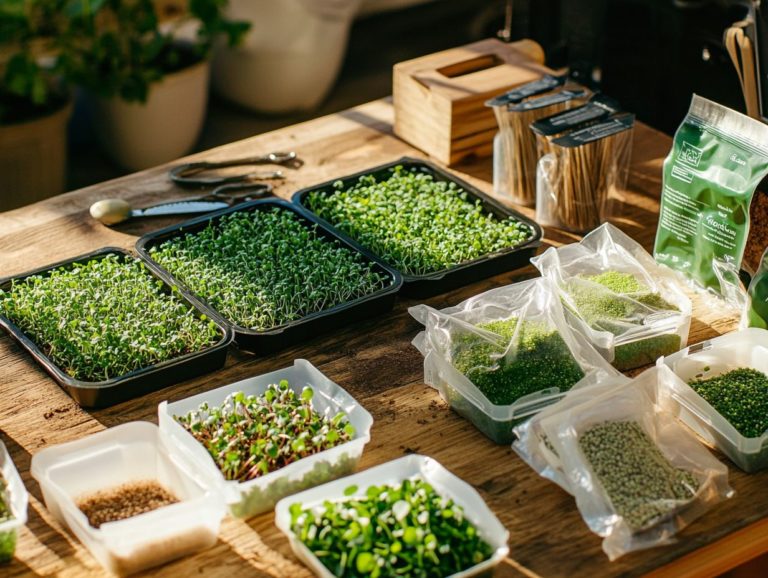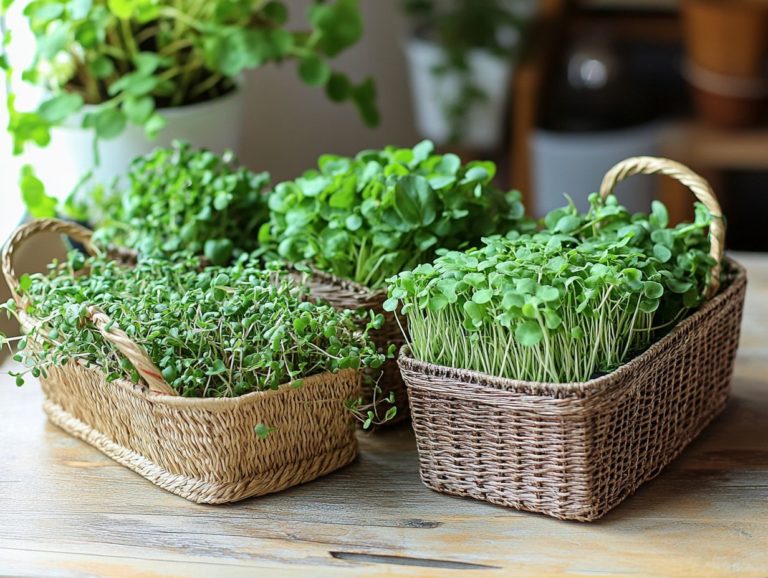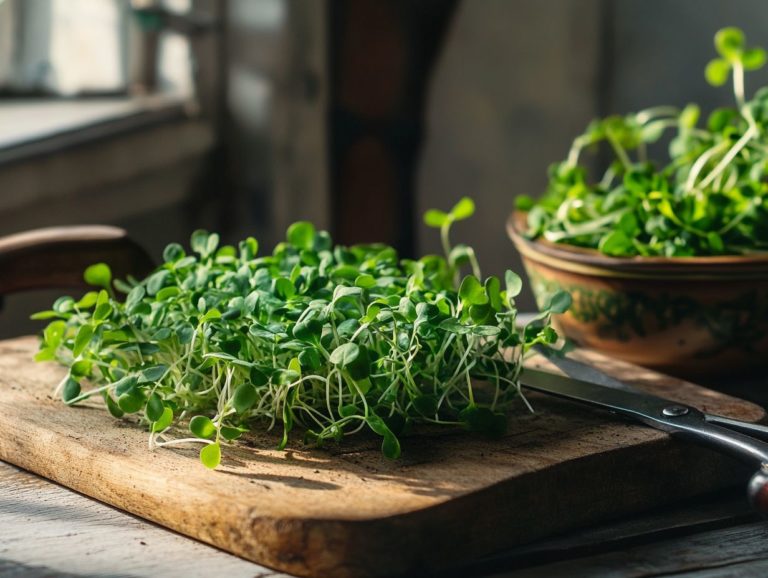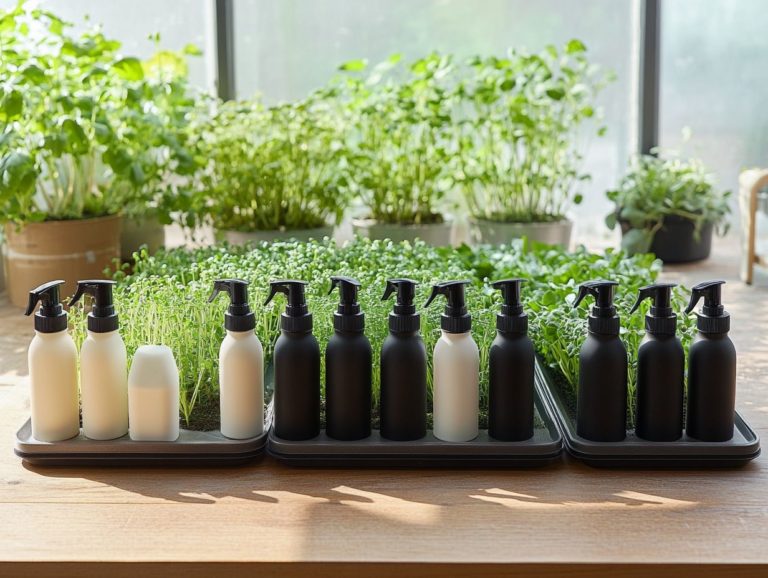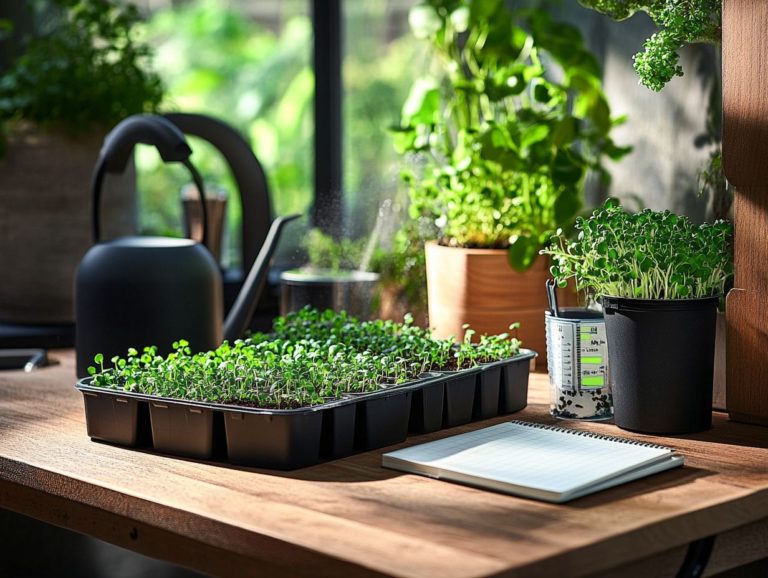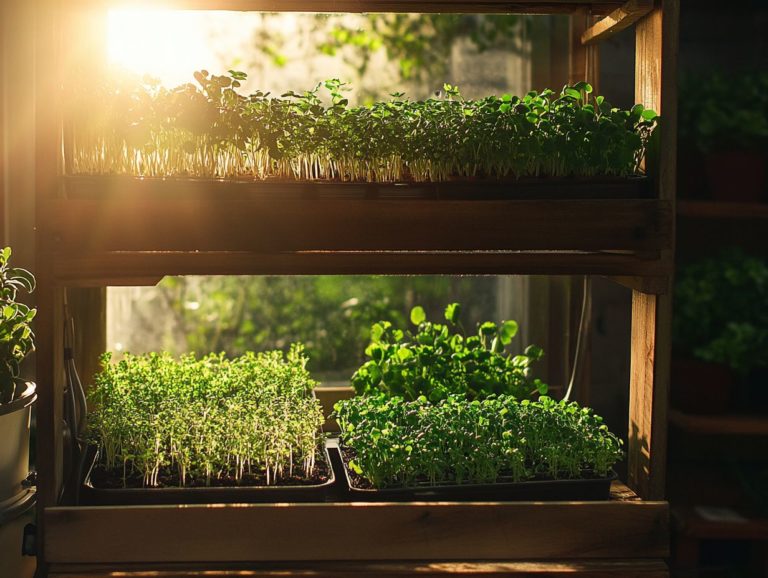5 Essential Features of Microgreen Trays
Microgreens have captivated both culinary enthusiasts and gardeners alike, delivering vibrant bursts of flavor and nutrition in beautifully compact forms.
If you’re thinking about cultivating your own microgreens, selecting the right tray is imperative.
This article delves into the five essential features that contribute to an effective microgreen tray: food-grade materials, optimal drainage, and stackable designs.
It also highlights the advantages of using these trays, guidance on selecting the perfect one, and essential tips for their care.
Keep reading to discover how you can boost your microgreen growing journey today!
Contents
- Key Takeaways:
- 1. Made of Food-Grade Materials
- 2. Proper Drainage Holes
- 3. Sturdy and Durable
- 4. Stackable Design
- 5. BPA-Free and Non-Toxic
- What Are Microgreens and Why Are They Popular?
- Frequently Asked Questions
- What are the 5 essential features of microgreen trays?
- Why is size an important feature of microgreen trays?
- How does ventilation play a role in microgreen trays?
- Why is proper drainage important for microgreen trays?
- What makes durability a crucial feature of microgreen trays?
- How does stackability benefit microgreen trays?
Key Takeaways:

- Made with food-grade materials to ensure safety and avoid contamination.
- Proper drainage holes for adequate water flow and prevention of mold growth.
- Sturdy and durable trays for long-lasting use and stackable design for efficient storage.
1. Made of Food-Grade Materials
Microgreen trays crafted from food-grade materials, such as those offered by Bootstrap Farmer and Home Microgreens, are essential for cultivating high-quality microgreens, ensuring that your plants thrive in a safe and healthy environment.
These specially designed trays improve seed germination and enhance nutrient retention, creating a great environment for growth.
The smooth surfaces of food-grade plastic not only prevent any buildup of contaminants but also simplify cleaning and maintenance, saving you precious time as a busy grower.
By choosing quality materials, you invest in durability, allowing for repeated use without compromising health standards. When you opt for reputable brands like Bootstrap Farmer and Home Microgreens, you’re on your way to enjoying better yields and healthier plants!
2. Proper Drainage Holes
Proper drainage holes in your microgreen trays are crucial for ensuring efficient watering, preventing mold growth, and maintaining the right moisture balance.
Each microgreen variety has unique requirements for optimal growth. Some thrive in drier conditions, while others flourish in moisture-rich environments. The trays’ shape and size affect drainage; deeper trays may retain more water, which can be either beneficial or detrimental, depending on the crop. To ensure proper storage, consider the 5 key factors for successful microgreen storage.
To optimize drainage, consider using materials like coconut coir or vermiculite, which promote aeration. Implementing a gentle watering system, such as a misting setup, can help you deliver moisture effectively without oversaturating the soil.
3. Sturdy and Durable
Sturdy and durable microgreen trays crafted from heavy-duty plastic are essential for your successful growing endeavors, ensuring longevity and resilience throughout the cultivation process.
These trays are designed to resist warping and cracking, even with repeated use, while providing excellent protection against water and soil exposure.
This remarkable durability makes them perfect for various planting techniques, giving you the power to confidently explore both hydroponics and soil-based methods.
Their robust design accommodates a wide range of plant varieties, from delicate herbs to nutrient-dense greens. This versatility enables you to create optimal conditions for microgreen harvesting, promoting faster growth and healthier crops while minimizing the need for frequent replacements.
4. Stackable Design
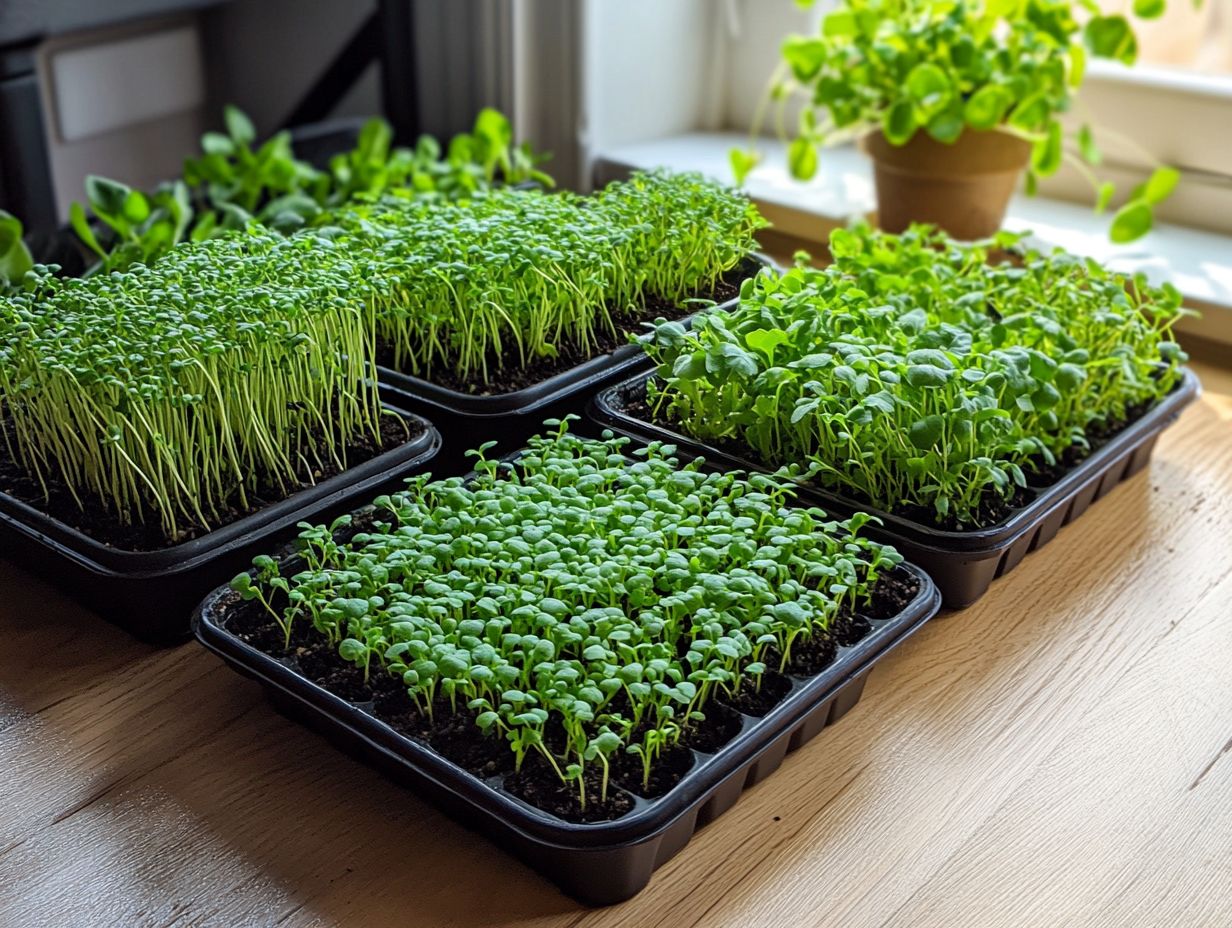
Imagine a stackable design in microgreen trays that offers a remarkable space-saving solution. This design enables you to optimize your growing area while ensuring each tray enjoys proper air circulation.
By embracing these innovative stackable trays, you elevate the organization of your compact spaces and enhance accessibility for watering and harvesting. This clever arrangement allows you to reach every layer effortlessly, eliminating the hassle of cumbersome rearrangements.
Utilizing a variety of container options tailored to different microgreen varieties can significantly improve your growth outcomes. Each type may thrive under unique conditions. For instance, you might choose one tray for faster-growing greens and reserve another for slower varieties. Additionally, following 5 tips for successful microgreen germination creates an ecosystem that is both efficient and highly productive.
5. BPA-Free and Non-Toxic
BPA-free and non-toxic microgreen trays are essential for ensuring the safety and quality of the microgreens you cultivate. This protects both your well-being and the environment.
Using food-safe materials protects against harmful chemicals that might leach into your plants and promotes better growth and yields. Chemicals like BPA can disrupt plant hormones, potentially leading to stunted growth. They also pose risks to your health through consumption.
When selecting your microgreen containers, it’s imperative to choose options made from food-grade polystyrene or polypropylene. These materials are safe for food contact and free from harmful chemicals. For the best results, consider choosing the right trays for microgreens. Ensuring proper drainage and ventilation in these trays enhances your growing conditions, allowing your microgreens to thrive while reducing risks from unsafe materials.
What Are Microgreens and Why Are They Popular?
Microgreens are delightful young edible seedlings harvested at just the right moment. They have taken the culinary world by storm due to their exceptional flavors, vibrant colors, and impressive nutrient profiles. These tiny greens can sprout from a variety of plants think broccoli or celery. They are simple to grow and packed with essential vitamins and minerals, making them an enticing option for anyone looking to cultivate their own food or elevate their diet.
Varieties like arugula, radish, and basil each bring unique flavor profiles and nutritional benefits, contributing to their widespread allure. For example, arugula offers a peppery kick with a healthy dose of vitamins A, C, and K, while basil adds a sweet aroma and boasts well-known anti-inflammatory properties.
The beauty of microgreens lies in their ease of cultivation. They require minimal space and resources, making them perfect for urban gardeners. To optimize your harvest, consider using 5 essential microgreen harvesting tools. Just sow the seeds in a shallow tray, ensure they get adequate sunlight or grow lights, and keep them moist.
These greens can elevate any dish to gourmet status, whether used as a topping for sandwiches, a garnish for soups, or a star ingredient in salads. Their versatility shines in both home kitchens and high-end restaurants, making them an exceptional addition to any culinary repertoire.
What Are the Benefits of Using Microgreen Trays?
Using microgreen trays provides a host of benefits that elevate your growing experience. You’ll enjoy optimized watering efficiency, improved sanitation, and the ability to cultivate high-quality microgreens with minimal effort.
These trays enhance air circulation, promoting healthier and more robust plants. By preventing overcrowding, they ensure each microgreen receives adequate light and nutrients, essential for optimal growth. To achieve this, consider the 5 essential nutrients for microgreen growth. They also simplify the harvesting process, allowing you to collect your greens without risking damage to those delicate plants.
With the right microgreen trays, you can effortlessly employ various cultivation methods, leading to consistent plant growth. This adaptability maximizes your yield and gives you the power to experiment with different seed varieties, letting you tailor your approach to your specific preferences and growing conditions using sprouting trays for microgreens.
What Are the Different Types of Microgreen Trays?
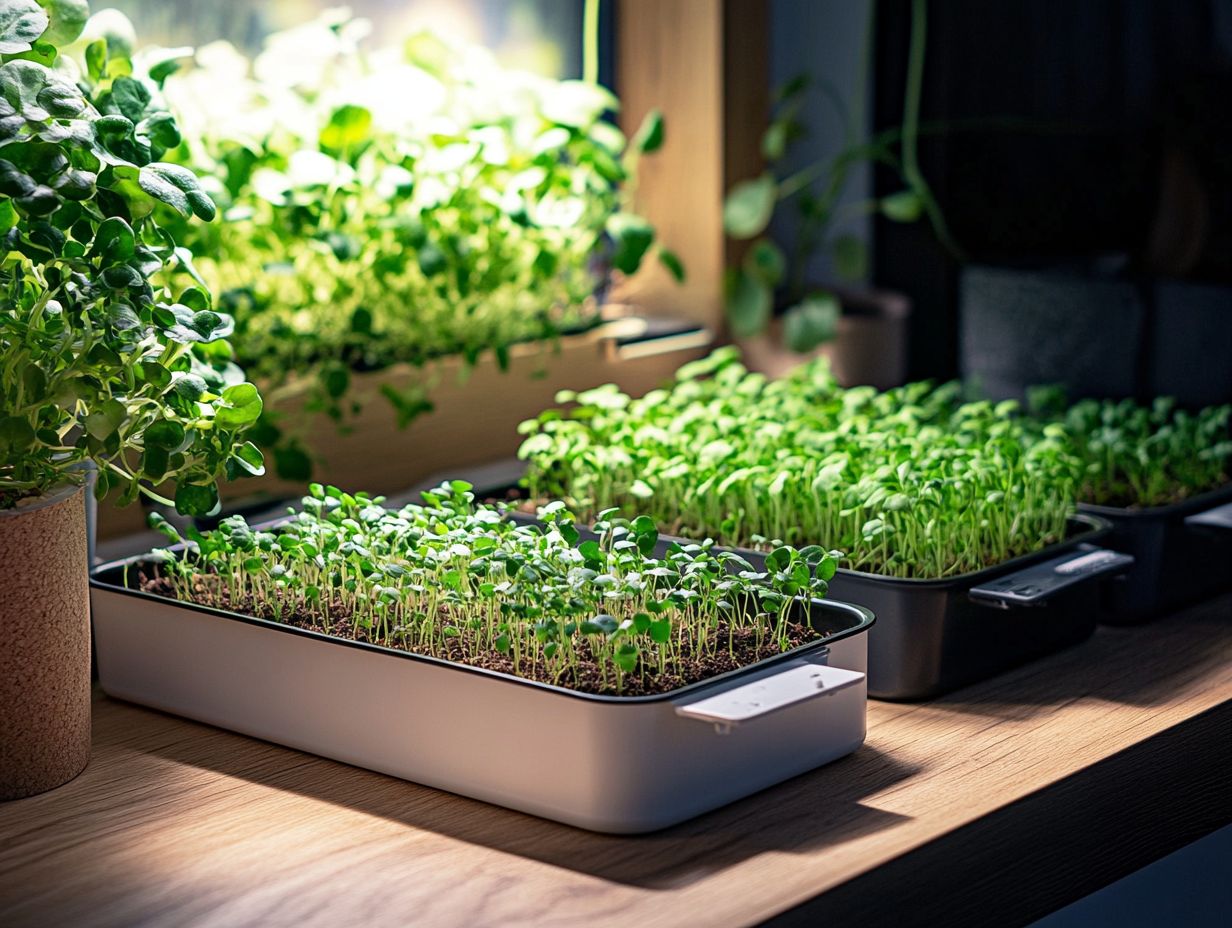
Different types of microgreen trays, including shallow and deeper options with varying dimensions, cater to your specific growing needs and preferences. This allows you to customize your growing system with ease.
Shallow trays are perfect for quicker-growing varieties like radishes and mustard greens, as they ensure good drainage and air circulation. In contrast, deeper trays are ideal for rootier species such as sunflowers and peas, providing ample space for robust root development.
You ll also find trays in different widths and lengths. This can be incredibly helpful for optimizing limited space or maximizing your yield in a confined area.
When selecting the right container, it’s essential to think about factors like drainage holes, material durability, and whether the tray is reusable or recyclable. Each tray type serves a unique purpose, so matching the container to the specific microgreens you want to cultivate is crucial for achieving the best results.
How Can One Choose the Right Microgreen Tray?
Choosing the right microgreen tray requires assessing various features that align with your growing area. This ensures optimal conditions for the microgreen varieties you ve selected.
Evaluate the size of your trays to ensure they create the best environment for seed germination. Proper drainage capability is also crucial; it helps prevent waterlogging and promotes healthy root development.
The quality of the materials used in the tray can greatly influence the success of your microgreen cultivation. Opting for high-quality, durable materials will allow your trays to resist degradation while withstanding the moisture and light exposure typical in growing settings.
By selecting trays with these key attributes, you can create ideal conditions that foster rapid growth and robust yields across a variety of microgreen species.
What Are the Common Mistakes to Avoid When Using Microgreen Trays?
Common mistakes when using microgreen trays can significantly hinder your growth and yield, so it s vital to avoid these pitfalls now!
A typical misstep involves improper watering techniques; oversaturating your trays can lead to mold, while insufficient moisture can stunt growth. Neglecting air circulation can create a welcoming environment for pests and diseases, ultimately compromising the health of your microgreens.
Another frequent error is overfilling trays, which can cause overcrowding and limit the light and nutrients that your young plants require.
To overcome these challenges, establish a consistent watering schedule, ensure proper spacing for optimal air flow, and adhere strictly to recommended filling levels. By doing so, you will foster a thriving microgreen environment.
How Can One Properly Care for Microgreen Trays?
Keep your trays thriving by regularly checking moisture levels. This helps prevent the pitfalls of overwatering and drying out, both of which can stunt growth.
Opt for high-quality soil media like peat moss or coconut coir. Not only do they provide essential nutrients, but they also ensure proper drainage to keep your plants happy.
Practicing clean handling techniques is vital. Use sanitized tools and containers to ward off contamination from pests or diseases. By following these best practices, you can cultivate thriving microgreens with minimal risk of complications, turning your gardening endeavors into a flourishing success.
Frequently Asked Questions
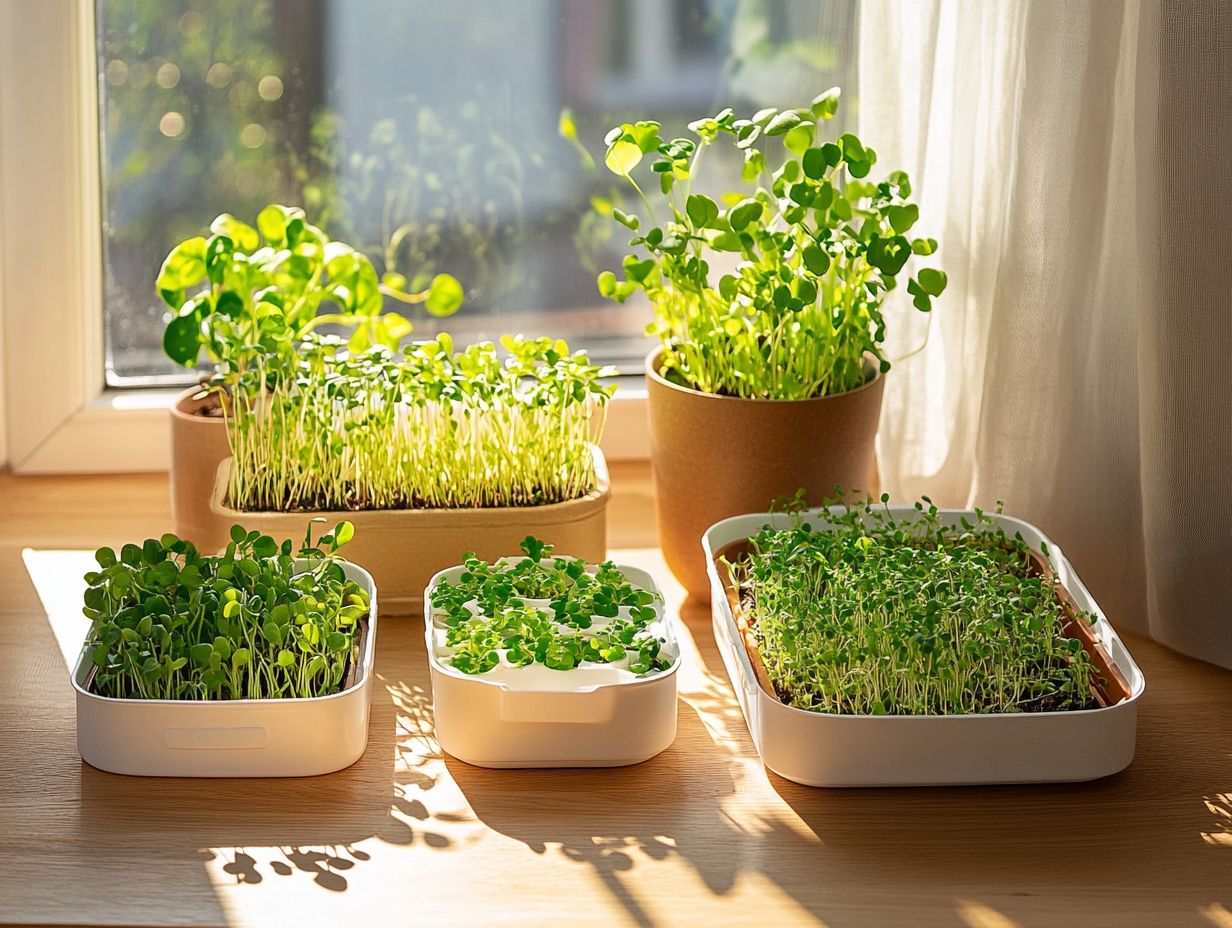
What are the 5 essential features of microgreen trays?
Microgreen trays have five essential features. They are size, ventilation, drainage, durability, and stackability.
Why is size an important feature of microgreen trays?
Size matters for microgreen trays. It affects how many plants you can grow and the space they require.
How does ventilation play a role in microgreen trays?
Good ventilation is key for microgreen trays. It helps air circulate, which prevents mold and encourages healthy growth.
Why is proper drainage important for microgreen trays?
Effective drainage is vital for microgreen trays. It prevents excess water from collecting and causing root rot.
What makes durability a crucial feature of microgreen trays?
Durability is crucial for microgreen trays. They must handle repeated use and frequent watering.
How does stackability benefit microgreen trays?
Stackable trays are a space-saver. They allow you to easily grow different types of microgreens together.

